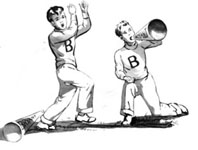
On Altar Servers & Serverettes
SAUL ALINSKY IN THE SACRISTY
I have preached parish missions and retreats around the U.S. and Canada since 1975. It is obvious that a segment of the Catholic population thinks that the “new” liturgy is “just great” while others (even in the Vatican) consider the situation ominous — and are calling for a “reform of the reform.” Only God knows what the gobs of ex- or nonpracticing Catholics think about the “new” Mass. Every Mass, whether accompanied by Gregorian chant or wretched polka music, is still the representation of Calvary and so a tremendous source of grace. At the same time, it can be a source of irritation or jubilation according to one’s aesthetic taste. Yes, one can pray and worship in the context of the Mass even if bombs are falling nearby or huge numbers of babies are crying or the goofy guitarist is mugging a maudlin tune slightly off-key. Still, the ideal is to have a Mass where one is drawn into the stream of contemplation and worship without having to endure distracting “accidentals.”
Catholics who still go to Mass have become, perforce, liturgy-watchers, and almost everyone seems to have a favorite cause. There are inculturation buffs, pronoun police ready to pounce on “sexist” language, decriers of the present flat language and poor translation of the liturgy, railers for and against Communion rails, Latin Mass enthusiasts, et al. So I decided I, too, would pick a cause: the altar server — and, for those linguistically sensitive, the “serverette.” I promise not to form a nationwide organization to promote my views.
After some disheartening experiences with altar servers in the 1970s, I wrote a piece for Homiletic and Pastoral Review (April 1978) wherein I brilliantly argued for the abolition of altar servers. The letters to the editor indicated that I was either holding an idea proximate to heresy (in addition to needing my head examined) or I was some crank who did not understand the meaning of having the “little people” on the altar (read possible vocations to the priesthood). At the time, I suggested that since there are two minor ministries that can be held by laymen as distinct from “boys,” the Church in the U.S. should strive to find and give the men (young and old) these ministries, an idea then and now not too favorably received.
It seemed evident by the late 1960s that the boys got bored with the new Mass, having very little if anything of importance to do, except to look like cute statues on the altar to parents and friends in the congregation. Boys already bored with Mass would make an unlikely crop of candidates for the priesthood, I thought. Years later, it is rare even to hear them make the responses at Mass — perhaps because that is what the adults do. Then too, the more important roles of the laity at Mass are now taken by adults, from reading to serving Communion. Even with good training and rehearsal, many of the young altar servers seem to act like us 60-year-olds, forgetting what to do, like pouring the water over the priest’s fingers at the “Lavabo” without a basin to keep the water from spilling on the floor, something I experienced in socially correct Beverly Hills many years ago.
You May Also Enjoy
A Carmelite monastery in Wyoming is an exciting new element in the Church in America, and has proven to be fecund ground for vocations to the consecrated life.
After attending various Masses and talking with parishioners, we came to the conclusion that parish success or decline depends on the homily of the pastor.
The Extraordinary Form and Ordinary Form sat down to discuss the first eight years of their formal co-existence, and invited me to record and moderate the conversation.

